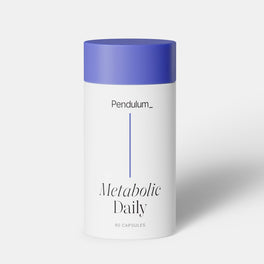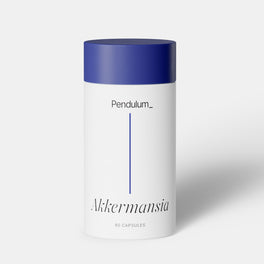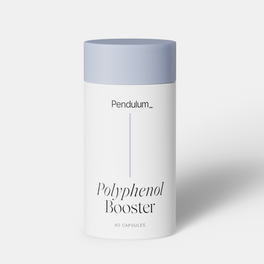Looks like your
cart is empty

Metabolic Daily
Improve metabolism

Akkermansia
Improves gut health

Polyphenol Booster
Increase antioxidants to protect cells
Stay in touch about special discounts, nutrition tips and additional education.
Looks like your
cart is empty

Improve metabolism

Improves gut health

Increase antioxidants to protect cells
It’s a fact: not all probiotic strains are created equal. Some are better for your gut, some not so much, some are readily available in most probiotics and can even be found in food, and some can’t be found in food and have only recently been discovered. So let’s play The Strain Game…we’re taking you beyond the basics of strains that are in most probiotics, to the novel, next generation strains available only at Pendulum.
First, let’s break down the name. Probiotic strains actually have three identifiable qualifiers: genus, species, and strain. For example, you'll see on our Butyricum bottle that we list Clostridium butyricum WB-STR-0006. Clostridium is the genus, butyricum is the species, and WB-STR-0006 is actually the strain. The genus, Clostridium, is a larger family and shares the name along with mutual traits with several other species, such as Clostridium beijerinckii. The species is butyricum; the species may have siblings with similar traits but they may have different abilities and serve different purposes. The strain is actually WB-STR-0006 and is unique to itself while also being recognizable as a member of a family.
All of this to point out that when we talk about probiotic strains, we are usually referring to the genus and species. A bit of a scientific misnomer, if you will.
Spend any amount of time looking at the probiotics market and you’ll notice a few names recurring again and again (and again). Within this narrow range of organisms, the most common names are Bifidobacterium and Lactobacillus. Think of them like the Jennifer and Jason of the probiotic world.
Within the Bifidobacterium genus, you might see the species bifidum, longum, infantis, breve, adolescentis, angulatum, catenulatum, pseudocatenulatum, and dentium. These are all common beneficial bacterial strains used in most probiotics on the market. However, you can also get this bacteria by eating yogurt, kefir, fermented foods, cured meats, certain wines, sourdough bread, and some vinegars.
Within the Lactobacillus genus, you might see the species casei, sakei, acidophilus, fermentum, plantarum, and crispatus. Like the Bifidobacterium family, these are all very common strains used in most probiotics on the market. However, you can also get these bacteria from eating certain foods such as yogurt, kefir, fermented foods, sourdough bread, and some vinegars.
With the most common beneficial bacterial strains available in food, why would anyone take a probiotic over simply eating nutritious food? It’s a good question, and one that many have asked in the face of the rapidly growing probiotic market. The truth is, if it’s an either/or situation, you’re better off eating foods that contain probiotics as you are also consuming micronutrients, phytochemicals, and fiber from those foods.
Of course, as we stated before, not all probiotics are created equal. Some probiotics can not be found in food, yet are incredibly beneficial to a healthy gut microbiome. That’s where Pendulum comes in.
In contrast to the common bacterial strains found in most probiotics are the next generation probiotic strains. Due to an influx of research in gut microbiome health and science, new strains of beneficial bacteria have been discovered, such as Akkermansia muciniphila, Anaerobutyricum hallii, and Clostridium beijerinckii.
Akkermansia muciniphila is a novel, next generation beneficial strain that’s often called the keystone strain for gut health. Akkermansia strengthens the gut lining, boosts sugar metabolism, supports GLP-1 production, and improves digestive health. Unlike the common strains found in other probiotics, Akkermansia is not found in food. You cannot eat your way to healthy Akkermansia levels. And unfortunately, 25% of people have low Akkermansia levels in their gut, and 18% have none at all. Fortunately, Pendulum found a way to manufacture this powerful anaerobic strain, and it’s available only through Pendulum as a daily probiotic.
Another novel, next generation strain that’s only available from Pendulum is Anaerobutyricum hallii (formerly called Eubacterium hallii). This unique strain is also not available in food, which is why it’s important to take it as a daily probiotic. This strain boosts sugar metabolism, produces butyrate, and supports GLP-1 production.
Lastly, we have Clostridium beijerinckii, yet another novel, next generation beneficial strain available only in Pendulum probiotics. This anaerobic organism also boosts sugar metabolism, produces butyrate, and supports GLP-1 production. Like the other next generation strains, this does not come from food, and is available only from Pendulum.
The truth is, there are no real losers in The Strain Game. Bifidobacterium and Lactobacillus are good for your gut. But your gut deserves more than the basic strains it can get from food. Your gut deserves the latest in microbiome research. Your gut deserves Pendulum.